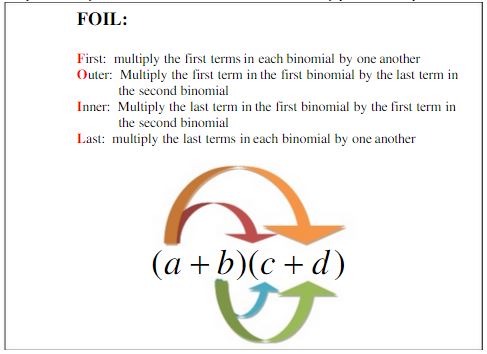Expanding
A Monomial Times a Binomial
If we have a monomial (the product of powers of variables) multiplying a binomial (2 monomials added together), then we simply make sure that the monomial multiplies both terms in the binomial.
Example: Expand 5x2 (3x -1)
Solution:
5x2 (3x -1)
=(5x2)(3x)+(5x2)(-1)
=15x3 - 5x2
A Binomial Times a Binomial
To multiply 2 binomials together, we need to make sure that each term in each binomial gets multiplied by each term in the other binomial. To help us do this, there is a useful acronym that helps us remember which terms we must multiply. The acronym is:
Example: Expand (x-7)(x+1)
Solution:
(x-7)(x+1)
=(x)(x)+(x)(1)+(-7)(x)+(-7)(1)
=x2+x-7x-7
=x2 -6x -7
Example: Expand (3x + 2)(2x - 5).
Solution:
(3x + 2)(2x - 5)
=(3x)(2x)+(3x)(-5)+(2)(2x)+(2)(-5)
=6x2 - 15x + 4x - 10
=6x2 -11x -10
A Few Notes
- If you have to expand the expressions you're expanding contain more than 2 terms each, just apply the principle that each term in the first expression must multiply each term in the second expression...that's the general rule that the FOIL idea was based on.
- If you have to multiply more than two expressions together, just proceed two at a time.
- If you know how to factor, remember that expanding is the opposite process of factoring, so if you were to factor after you're done expanding, you'd get the original expression in the question. Similarly, if you're to expand after factoring you'd get the original expression as well...this is a useful way to check your work!
Example 1:
Example 2:
Example 3:
Avoiding Common Math Mistakes when Expanding:

